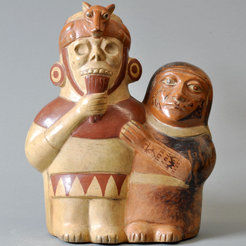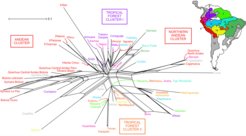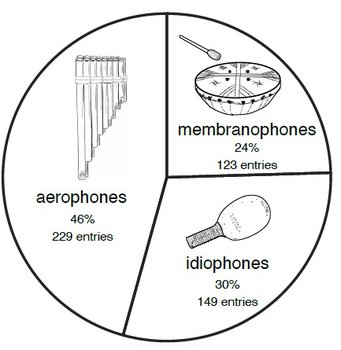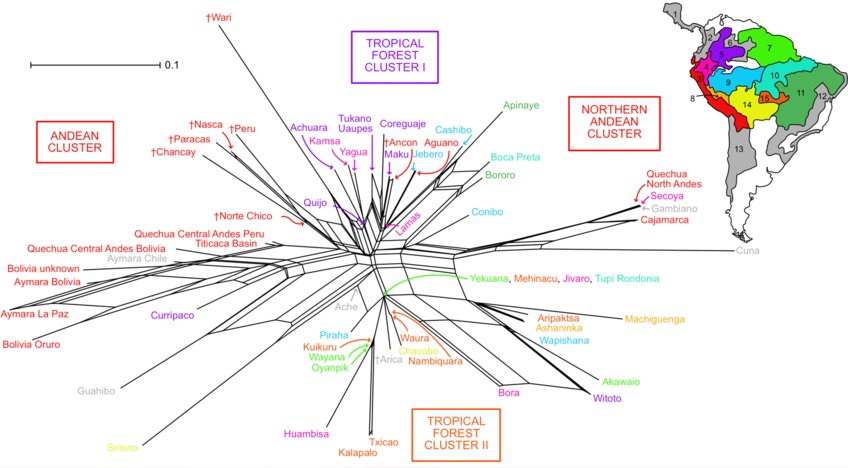South American Musical Instruments Reflect Population Relationships
A new study provides the first systematic review of musical instrument diversity in the archaeological and ethnographic history of the continent, suggesting cultural contact over long geographic distances, and cases of recent extinction.

Music is an intrinsic expression of cultural diversity and a fundamental element of identity, ritual symbolism, and daily social interaction. The study of material culture, and musical instruments in particular, represents therefore a relevant and innovative tool to characterize societies and reconstruct their historical trajectories and relationships in time and space.
South America harbors a rich diversity of cultures and languages, which are shaped by different demographic scenarios and adapted to a variety of ecologies and landscapes. In this study, a joint project with the University of Zurich and the Max Planck Institute for the Science of Human History, researchers analyzed music diversity over the entire South American continent with a systematic review of the different instruments found in both the archaeological and ethnographic record, with a focus on Indigenous knowledge and pre-colonial history.
Exceptional diversity from the archaeological record
The authors started by reviewing one of the most popular classifications of global organology (the study of musical instruments): the system of von Hornbostel and Sachs, assembled at the beginning of the 20th century. The classification breaks down from four main classes of instruments: idiophones (vibration of the instrument itself e.g., a rattle), membranophones (vibration of a membrane, e.g., a drum), chordophones (vibration of strings, e.g., a guitar), and aerophones (vibration of wind, e.g., a flute).

Gabriel Aguirre-Fernández, a paleontologist from the University of Zurich and first author of the study, started his journey into musical diversity from a macroevolutionary perspective, interested in shapes and functions. Together with PhD student Anna Graff from the University of Zurich and a team of South American-based ethnomusicologists and archaeologists, they expanded and refined this classification, incorporating 40 years of work documented by ethnomusicologist and coauthor José Pérez de Arce from the University of Chile.
“One finding of our systematic review is the prominent role of aerophones for South America in comparison to other continents, particularly in the archaeological record,” says Aguirre-Fernández. “Even considering that not all materials used to make instruments have equal chances of being preserved—organic materials such as plants and bones do not preserve as well as inorganic materials like stone and clay —more than one third of the aerophones in South America were found exclusively in archaeological excavations, with no records of usage in the more recent ethnographic record. This suggests that many kinds of instruments went extinct, and are no longer part of the musical repertoire of Indigenous populations. The influence of European colonizers, who massively disrupted the local cultural repertoire, is likely playing a part in these extinction events,” adds Graff.
Cultural and linguistic connections
From a cultural evolution perspective, the sharing of instruments can testify to a shared historical path. The transmission of knowledge is influenced by two modalities: vertical transmission, with information passing within a group from one generation to the next, and horizontal transmission, with information passing through contact with peers or other groups.
Chiara Barbieri, a geneticist working at the University of Zurich and affiliated to the Max Planck Institute for the Science of Human History in Jena, works with the demographic and linguistic history of South America. “We found groups who speak related languages and share the same set of instruments, and this can describe particularly meaningful connections, with stable vertical transmission of cultural features and materials,” says Barbieri, who co-led the study. “We also recovered east-west connections across the Amazonian basin, with groups sharing the same or similar instrument sets at long geographic distances. These findings, contextualized with historical, archaeological, linguistic and genetic evidence, have a strong potential to illuminate past chapters in South American history.”
“The panpipes are particularly interesting,” adds Aguirre-Fernández. “We focused on them in a case study because of their great diversity of forms and widespread presence in the continent. By analyzing panpipe features in different societies, we recovered relationships which mirror regional and cultural areas of influence, corresponding to the northern Andes, the southern Andes, and an Amazonian core.”

Digital catalogues of material culture
Marcelo Sánchez-Villagra, paleontologist from the University of Zurich who coordinated the study, highlights the importance of cataloguing human artifacts into such systematic collections. By traveling to museums and discussing his findings with musicologists and anthropologists, he is convinced that this work is as relevant as existing research on other artifacts, like ceramic styles, which are more commonly studied at broad geographic scales.
“We hope to continue our study with more fine-grained mapping of musical instruments and discussing the relevance of their features for performance and music production. With an even more robust dataset it will be possible to test questions of cultural evolution and apply advanced models to the data,” concludes Sánchez-Villagra.


